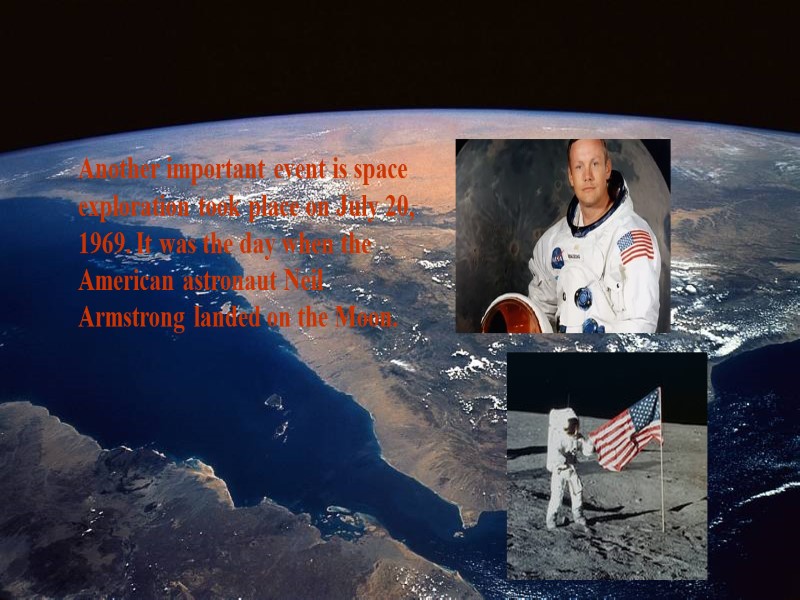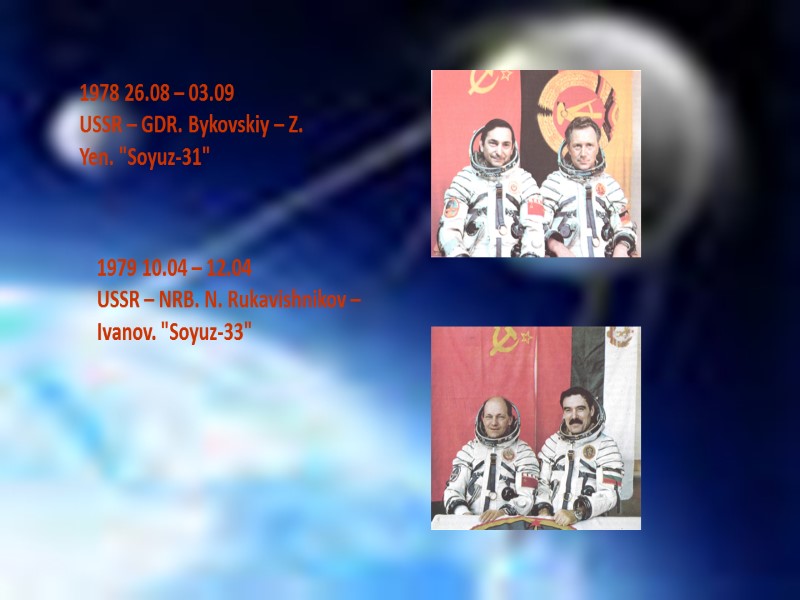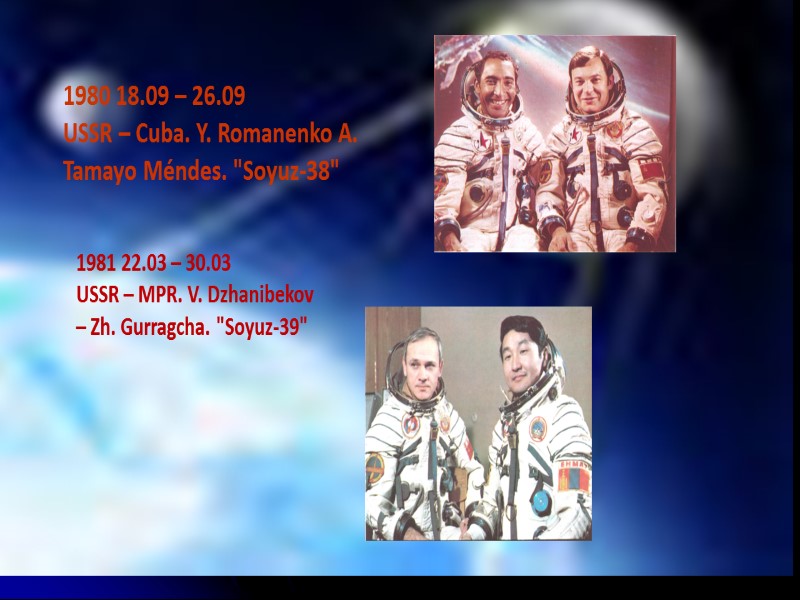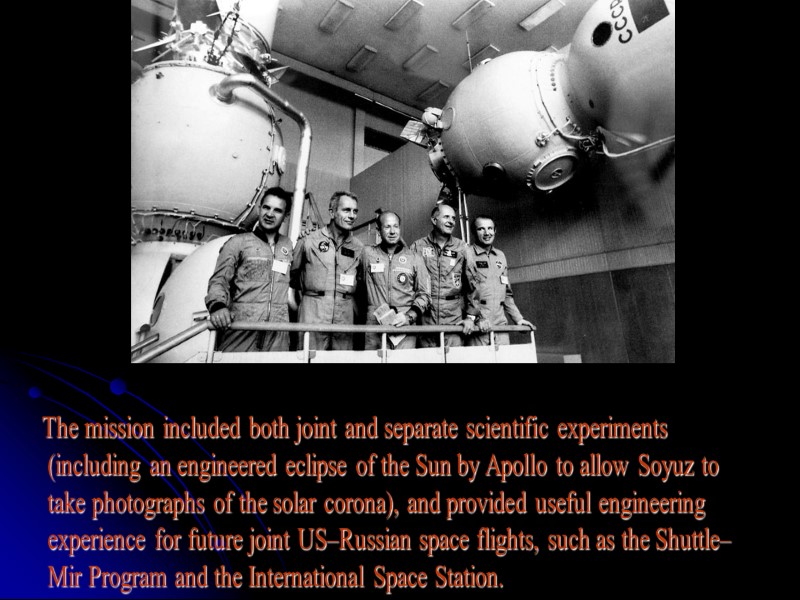International Flights into Space Made by Bondareva E.A.


International Flights into Space Made by Bondareva E.A. Emyasheva L.V. Zaharova E.A. School 14


People have always dreamt of travelling in space and reaching other planets. At the beginning of the 20th century a famous Russian scientist Tsiolkovsky said that mankind will not live on the planet Earth forever. His predictions came true half a century later.

This first man who overcame gravitation was Yuri Gagarin. After successful orbiting, he returned to the Earth. This flight encouraged many other Russian cosmonauts to explore the outer space..

Another important event is space exploration took place on July 20, 1969. It was the day when the American astronaut Neil Armstrong landed on the Moon.

Apr 2001 Greg Olsen (US) Soyuz TMA-7, Oct 2005 Mark Shuttleworth (S. Africa/UK) Soyuz TM-34, Apr 2002 Anousheh Ansari (Iran/US) Soyuz TMA-9, Sep 2006 Charles Simonyi (Hungary/US) Soyuz TMA-10, Apr 2007 Richard Garriott (UK/US) Soyuz TMA-13, Oct 2008 US company Space Adventures forms agreement with Russian Space Agency for space tourism trips to International Space Station. Cost $20-30 million SPACE TOURISM

The first space tourist in the world were Toyohiro Akiyama and Helen Sharman – citizens of Japan and the UK. They first made a sightseeing flight to the Soviet space station Mir on “Soyuz” ships in 1989 and 1990. The flight was sponsored within the bounds of non-state project of television company TBS and a consortium of British television.


The first international scientific space expeditions 1978 02.03 – 10.03 USSR – CZECHOSLOVAKIA. A. Gubarev, V. Remek. "Soyuz-28" 1978 27.06 – 05.07 THE USSR – PNR. P. Klimuk – M. Hermashevsky. "Soyuz-30"

1978 26.08 – 03.09 USSR – GDR. Bykovskiy – Z. Yen. "Soyuz-31" 1979 10.04 – 12.04 USSR – NRB. N. Rukavishnikov – Ivanov. "Soyuz-33"

1980 26.05 – 03.06 THE USSR – HUNGARY. V. Kubasov, B. Farkas. "Soyuz-36" 1980 23.07 – 31.07 USSR – VIETNAM. Gorbatko – Pham Tuan. "Soyuz-37"

1980 18.09 – 26.09 USSR – Cuba. Y. Romanenko A. Tamayo Méndes. "Soyuz-38" 1981 22.03 – 30.03 USSR – MPR. V. Dzhanibekov – Zh. Gurragcha. "Soyuz-39"

1981 14.05 – 22.05 THE USSR – THE RAF. L. Popov And D. Prunariu. "Soyuz- 1982 24.06 – 02.07 USSR – France. V. Dzhanibekov, Ivanchenkov A. – J.-L. Chrétien. "Soyuz T-6"

1984 03.04 – 11.04 The USSR – India. Y. Malyshev, G. Strekalov, R. Sharma. "Soyuz T-11" 1987 22.07 – 30.07 USSR – Syria. A. Viktorenko, A. Alexandrov, M. Faris "Soyuz TM"

December 21, 2009. Baikonur launch site, branch office of S.P. Korolev RSC Energia In accordance with the International Space Station (ISS) Mission Program and the Russian commitments under this International Project, the Soyuz TMA-17 manned transport spacecraft was launched from the Baikonur Cosmodrome at 00:52:00 Moscow Time. The Soyuz TMA-17 crew: Oleg Kotov (Soyuz Commander, Russia), Thimothy J.Creamer (Flight Engineer, USA) and Soichi Noguchi (Flight Engineer, Japan)


.Space exploration is quickly progressing and it seems that soon we’ll be visiting other planets and even living on them. The 21st century may be the turning point. Our country has the only space station in the world, more launch vehicles than any other country and, of course, the only “real (long-term) experience” living and working in space. A lot of countries are involved in cooperative space projects with Russia. We’ll be proud not only of our past achievements in the space but of the future ones as well.

Apollo-Soyuz Test Project

The Apollo–Soyuz Test Project (ASTP) conducted in July 1975, was the first joint U.S.–Soviet space flight, and the last flight of an Apollo spacecraft.

Its primary purpose was as a symbol of the policy of detente that the two superpowers were pursuing at the time, and marked the end of the Space Race between them that began in 1957.

The mission included both joint and separate scientific experiments (including an engineered eclipse of the Sun by Apollo to allow Soyuz to take photographs of the solar corona), and provided useful engineering experience for future joint US–Russian space flights, such as the Shuttle–Mir Program and the International Space Station.

ASTP was the last manned US space mission until the first Space Shuttle flight in April 1981. It was also U.S. astronaut Donald "Deke" Slayton's only space flight. He was chosen as one of the original Mercury Seven astronauts in April 1959, but had been grounded until 1972 for medical reasons.

While the two ships were docked, the three Americans and two Soviets conducted joint scientific experiments, exchanged flags and gifts, signed certificates, visited each other's ships, ate together, and conversed in each other's languages. (Because of Stafford's pronounced drawl when speaking Russian, Leonov later joked that there were three languages spoken on the mission: Russian, English, and "Oklahomski.") There were also docking and redocking maneuvers, during which the two spacecraft reversed roles and the Soyuz became the "active" ship.

American scientists developed four of the experiments performed during the mission. Embryologist Jane Oppenheimer analyzed the effects of weightlessness on fish eggs at various stages of development. After 44 hours together, the two ships separated, and maneuvered to use the Apollo to create an artificial solar eclipse to allow the crew of the Soyuz to take photographs of the solar corona. Another brief docking was made before the ships went their separate ways. The Soviets remained in space for five days, and the Americans for nine, during which the Apollo crew also conducted Earth observation experiments.

The International Space Station (ISS) is a space station, or habitable artificial satellite, in low Earth orbit. Its first component launched into orbit in 1998, and the ISS is now the largest artificial body in orbit and can often be seen with the naked eye from Earth. The ISS consists of pressirised modules, external trusses, solar arrays and other components. ISS componenets have been launched by Russian Proton and Soyuz rockets as well as American Space Shuttles.


The ISS serves as a microgravity and pace environment research laboratory in which crew members conduct experiments inbiology, human biology, physics, astronomy, meteorology, and other fields. The station is suited for the testing of spacecraft systems and equipment required for missions to the Moon and Mars. The ISS maintains an orbit with an altitude of between 330 and 435 km (205 and 270 ml) by means of reboost manoeuvres using the engines of the Zvezda module or visiting spacecraft. It completes 15.54 orbits per day. ISS is the ninth space station to be inhabited by crews, following the Soviet and later Russian Salyut, Almaz, and Mir stations as well as Skylab from the US. The station is serviced by a variety of visiting spacecraft: Soyuz, Progress, the Automated Transfer Vehicle, Dragon, and Cygnus. It has been visited by astronauts, cosmonauts and space tourists from 17 different nations.







en.wikipedia.org 2) space.com 3) ria.ru
6584-international_flights_into_space.ppt
- Количество слайдов: 34

